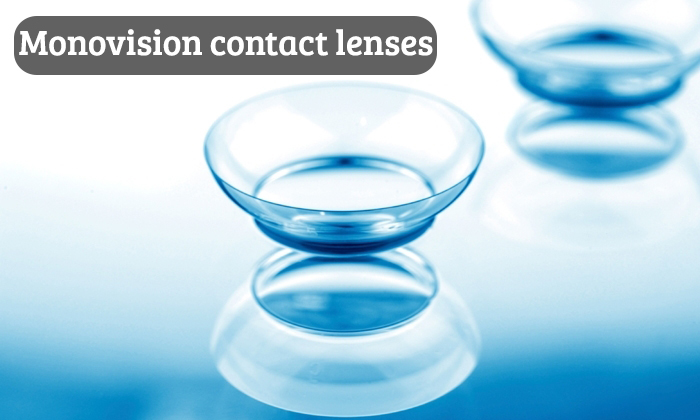The term “Monovision” indicates wearing of one contact lens that corrects only distance vision in one eye and wearing of another contact lens that corrects only near vision in another eye. Monovision contact lenses are used particularly in focusing problems that are associated with age-related conditions called “Presbyopia.” Many people found good results with monovision contact lenses and can avoid the use of reading glasses. For monovision patients, the stronger eye will be fitted with the contact lens that is suited for performing activities that need focusing on far objects. In case of focusing closer objects, blurry appearance may be observed through this eye. The recessive or the weaker eye is fitted with a lens that is used to see close objects. This eye functions better for reading or doing more intimate works while the distant objects will look blurred through this eye. Let’s know the different types of Monovision lenses.
Different Types of Monovision Contact Lenses
Based on your daily requirements of the vision and the reactions to monovision with contact lenses, your eye care practitioner recommends the best form of monovision that suits your needs and he performs a monovision contact lens fitting to you. The following are the different types of monovision contacts.
- Mini Monovision: In this type, a less than typical magnifying power is added to the near vision lens. It is an excellent solution for those people who observe that standard monovision does not work in showing sharp distance vision. It is a great option for one who goes out for daytime driving and working on a computer for little time or reading.
- Computer Monovision: This type of monovision requires less magnification in the eye that is used to visualize closer objects. The result is that presbyopia patients using this type of monovision will be able to see at a mid-distance such as the distance of the computer screen, but still requires reading glasses for regular reading of the matter. If you want to retain better far vision, it’s a good
- Modified Monovision: Modified monovision provides sharper distance vision and acceptable near vision without the use of reading glasses for many close up works. People who choose this type of monovision wears a single vision contact on the distance eye and a bifocal contact lens on the near eye to see close objects. This monovision helps to retain clearer distance vision and depth perception.
- Surgical Monovision: Monovision can be accomplished with surgery for presbyopia condition that includes Conductive Keratoplasty (CK), Laser In Situ Keratomileusis (LASIK) and other lens or Corneal Based Refractive Surgeries. LASIK surgery is mainly done on the cornea to adjust one eye for focusing on far objects and the other eye for focusing on closer objects. An eye care specialist will recommend using monovision contact lenses for 2-3 week period before committing to a surgical operation.
Functions of Monovision Contact Lenses
Monovision Contact Lenses are acceptably comfortable, bright and sharp with good vision at all distances. Most of the people get adjusted to monovision quickly due to its better functions. In order to understand how monovision resolves the problem of a presbyopia person, we need to focus on the functions of an eye accommodation. Check out the functions of monovision lenses.
- The eye can see an object clearly at a distance with the help of power accommodation factor. For example, if you want to see a close object like a book or sewing needle, the eye enlarges its accommodative power by changing the shape of the crystalline lens, focusing in on the near objects and allows it to see clearly.
- This accommodation power gets diminished during mid 40’s and early 50’s leading to a condition called presbyopia. To overcome this problem an optical lens like monovision is used to correct this condition.
- Adaptation to monovision contacts usually takes about 1 to 2 weeks, after which the brain begins to use flawlessly the eyes in a monovision manner.
- It provides a person with a good quality of vision and freedom from reading eyeglasses.
- Each theoretical pair of monovision has a unique function. One contact lens helps in correcting your distance vision, and the other one helps in correcting your near vision.
- The lens for near vision is worn on your weak eye, whereas the lens for distance vision is worn on your dominant eye.
- If you wear monovision contacts and close your reading lens eye and try to see close objects with your distance lens, then those objects seem to be in blurred mode. The same thing happens if you close your distance eye and try to see the distance with your eye that possess the reading prescription contact.
- As your brain processes primary information from both eyes, you can make adjustments to look through monovision lenses together for correcting both eye visions.
- The prescription power of the distance contact requires slight adjustments either increasing or decreasing to alleviate perception problems.
- Over wearing your lenses at first time causes swelling and other visual problems. Make sure to follow your prescribed wearing schedule and get used to monovision contacts.
Monovision helps you to achieve high functional vision at distance or near point. However it may not be a perfect one, but a better compromise between clarity at a distance or near allows the patient to adapt entirely to monovision and correct vision accurately. This monovision may decrease depth perception that could affect job or athletic performance. The best way to find out whether monovision works for you is to seek your eye specialist and take good advice from him. Change your vision with the most challenging adaptation monovision with contact lenses!

